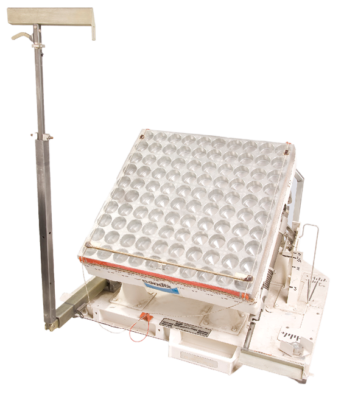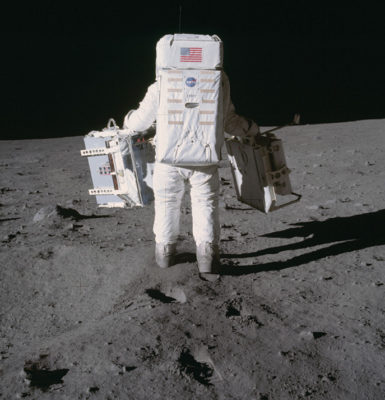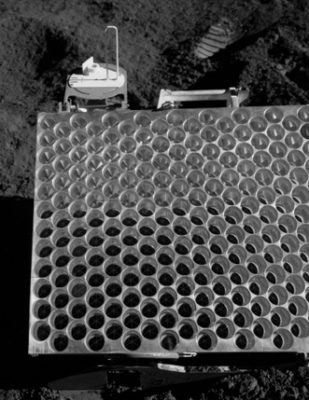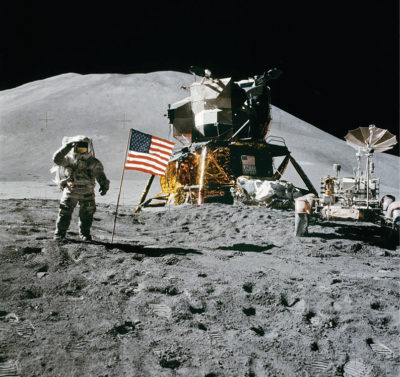
Buzz Aldrin stands next to the Passive Seismic Experiment Package (PSEP) while being photographed by Neil Armstrong. Above and beyond it is the Laser Ranging Retro-Reflector (LR-3). These were the first measuring devices placed on the surface of the moon during Apollo 11 on July 21, 1969. Courtesy of NASA.
July 20, 1969, 20:17 UTC. “Houston, Tranquility base here. The Eagle has landed.” Neil Armstrong calmly communicated these words from the surface of the moon to those patiently waiting on earth. Six hours later, Armstrong exited the lunar module, Eagle, and stepped onto the lunar landscape at 02:56:15 UTC on July 21, 1969. Edwin “Buzz” Aldrin joined Armstrong 19 minutes later on the Mare Tranquillitatis, while command module pilot Michael Collins piloted Columbia in lunar orbit. Apollo 11 was deemed a complete success—they had made it.
Determining the distance to the moon during all phases of its orbit was a critical aspect in getting man to its surface. In the 2nd Century BC, Greek astronomer Hipparchus is believed to be among the first to determine the distance to the moon with some degree of accuracy. His method observed how shadows worked over a long period and determined that when a spherical object is placed in front of the sun, the length of the shadow generated would always be 108 times the diameter of the object itself. Another early method to determine the lunar distance, known as lunar parallax, involved simultaneously measuring the angle between the moon and a chosen reference point from multiple locations.
A somewhat similar method, known as meridian crossing, involved lunar transits observing the moon as it crossed the meridian from two different locations. Repeated measurements by this method were made between 1905-1910 to determine the angle of elevation at the moment the specific lunar crater, Mösting A, crossed the meridian. Observation stations for this work were located at Greenwich and at Cape of Good Hope, which share nearly the same longitude. The calculated distance by the meridian crossing method had an uncertainty of about 20 miles and became the definitive lunar distance value for the next half century.

This Retro-Reflector, manufactured by the Bendix Corporation, is identical to the one placed on the moon during Apollo 11. It contains 100 reflectors. Courtesy National Air and Space Museum.
In 1957, earth-based measurements to the moon began being made by radar at the U. S. Naval Research Laboratory while using a 50-foot diameter radio dish. An expanded program with the creation of the National Aeronautics and Space Administration (NASA) in 1958 increased the intensity of radar measurements to the moon. On May 25, 1961, President John F. Kennedy stated the goal should be to land a man on the moon and safely return by the end of the decade. Soon thereafter, an experiment in 1962 by the Massachusetts Institute of Technology, known as laser ranging, measured the round-trip time that laser pulses reflected directly off the surface of the moon.
Because the United States and the Soviet Union were both intensely exploring space, the ground-based measurements to the moon were continually being refined. Rocket technology for both countries had been bolstered by the capture of German equipment and scientists during WWII. By utilizing this technology, a series of probes were sent by both countries toward the moon during the Soviet Luna program and the American Pioneer program. The first manmade object to reach the moon occurred on September 14, 1959, when the Soviet Union’s Luna 2 purposely crashed upon the surface, prompting the United States to accelerate their space exploration with their Ranger program. This program involved nine spacecraft sent to the moon with an objective to obtain close-up photos of the surface between August 23, 1961, and March 21, 1965. Ranger 4 became the first spacecraft from the United States to touch the surface when it unintentionally struck the far side of the moon on April 26, 1962, as the result of an onboard computer failure.

Neil Armstrong photographs fellow astronaut Buzz Aldrin as he moves away to place equipment carried with them during the Apollo 11 landing on July 21, 1969. In Aldrin’s right hand is the first laser ranging retro-reflector. Courtesy of NASA.
With sufficient measurements to the moon, the next objective for NASA under the direction of the Jet Propulsion Laboratory was to soft land an unmanned spacecraft on the surface with the Surveyor program. This feat, however, was also first achieved by the Soviet Union on February 3, 1966, with their Luna 9. The Surveyor program launched seven spacecraft between May 30, 1966 and January 7, 1968, to land on the moon and also obtain lunar and cislunar photographs. Surveyor 1 achieved the first successful soft landing for the United States on June 2, 1966, by setting down within 9 miles of its intended target.
Despite the initial success, the Surveyor program was not without two significant mishaps. During the midcourse maneuver for Surveyor 2 to land at the intersection of the moon’s equator and guide meridian (Sinus Medii), one vernier engine failed to ignite resulting in its crash. Radio signal with Surveyor 4 was lost minutes before touchdown so it was believed to have exploded before reaching the surface. Five of the Surveyor spacecraft, however, successfully achieved soft landings on the surface and remain there today. An estimated 87,000 images were taken by the Surveyor spacecraft and transmitted back to earth. Years later, the astronauts of Apollo 12 were able to walk to the site of Surveyor 3 and remove some of its parts.

On February 5, 1971, during the Apollo 14 mission, astronauts Alan B. Shepard and Edgar D. Mitchell placed the second laser ranging retro-reflector on the surface of the moon. Courtesy of NASA.
The final program by NASA that preceded the Apollo program, and was concurrent to the Surveyor program, was the five unmanned missions of the Lunar Orbiter program from August 10, 1966, to August 1, 1967. This program was designed to take high-resolution images at specific sites in preparation for the upcoming Apollo landing locations. The Lunar Orbiters achieved a 99% success of mapping the surface at a resolution of 200’ or better. Images were simultaneously transmitted back to earth and all five spacecraft were intentionally commanded to crash upon the moon’s surface.
The manned Apollo program began with difficulty when a cabin fire inside Apollo 1 resulted in the deaths of three astronauts on the launch pad during a rehearsal on February 21, 1967. This setback delayed manned missions until Apollo 7 in October 1968. Through perseverance, the success of finally getting Apollo 11 to the moon in July of 1969 was the culmination of more than a decade of intense space exploration, measurements from earth, and lunar photogrammetry with each step critical in understanding how to get there and return.

The final and largest of the three American laser ranging retro-reflector arrays placed on the moon was left by astronauts Jim Irwin and David Scott on July 30, 1971, during Apollo 15. Courtesy of NASA.
One key result of the Apollo 11 landing was the placement of a 2-foot-wide array studded with 100 prisms known as the Lunar Laser Ranging Retro-Reflector Array. Two other prism arrays (also referred to as corner cubes) were placed near Fra Mauro during Apollo 14 and near Hadley Rille during Apollo 15 in 1971. The array left by the crew of Apollo 15 was three times larger than the previous two and three-quarters of the measurements taken during the first 25 years of the experiment were measured to this array. The Soviet Union also left two arrays during their unmanned Luna 17 and Luna 21 missions in 1970 and 1973.
Measurements to the five retro-reflector arrays are currently being made during one-hour intervals for an average of six sessions per month at the Apache Point Observatory Lunar Laser-ranging Operation (APOLLO) located 10 miles southeast of Alamogordo, New Mexico. Professor Thomas Murphy of the University of California-San Diego leads a team to take the readings with a 500-lb. laser that is mounted to the Astrophysical Research Consortium’s (ARC) 3.5-meter telescope. Aiming the laser at one of the five moon-based reflectors can be a challenge while the moon moves in its own elliptical orbit. The team typically begins by finding a star within 10 degrees of the moon for rough pointing. They next look for familiar topographic features across the moon’s 0.52-degree diameter surface as viewed from earth. With the exception of the reflector array placed by Apollo 15 near Hadley Rille, the other four arrays are located in featureless areas. Pointing the telescope has to be within one arc-second before the photons will begin returning.

This massive telescope sits within the Apache Point Observatory near Alamogordo, NM, from which the measurements are made to the five moon-based retro-reflectors. Courtesy of New Mexico State University.
Receiving repeated return signals of photons ensures the target has been located before the telescope can be set to automatically track. The automatic tracking of the telescope, however, can drift as much as five arc-seconds during the hour-long measurements, so periodic readjustments are required. By the time the laser reaches the surface of the moon, it has already spread out up to two kilometers. Although it would seem a full moon would be the optimum opportunity to make the measurements, Murphy has discovered this usually isn’t the case. The direct sunlight coming down into the reflectors is thought to be causing a thermal issue which disrupts the measurements. One theory suggests the nearly fifty years of possible lunar dust accumulating upon the individual prisms in correlation to the direct sunlight striking and heating the particles is causing the disturbance. While the exact amount of dust that has accumulated on the prisms within the arrays is uncertain, it is believed they might be 50% covered. Scientists, however, are still uncertain how dust reacts on the surface of the moon without atmosphere and believe the footprints left by the astronauts during the Apollo missions are likely still visible. In the event missions are someday resumed to the moon, a new generation of retro-reflector prisms are currently being developed so they will be ready.

This cut-away drawing shows the Astrophysical Research Consortium’s 3.5-meter telescope at the Apache Point Observatory. Courtesy of New Mexico State University.
Repeated measurements to the moon are necessary for a variety of reasons. Scientists and physicists are currently using the collected data to better understand how gravity works. Einstein’s general Theory of Relativity and Gravitation, published in 1915, is the current description of gravitation in modern physics, so the measured distances to the moon are being used to both support this theory and to also see if another theory of gravity might exist. Understanding the moon’s gravity is a key element of research to further study the earth’s steady axis. While tidal patterns are the most visual affect the moon has upon the earth, its entire influence is still being discovered. Botanical research indicates the moon might be controlling the movement of water within the leaves of trees and other plants.
Although measurements from the earth to the moon can now be made with millimeter-precision to the retro-reflectors, the lunar distance, or average distance from the center of the earth to the center of the moon, is generally expressed to the nearest average mile. Most sources place that average at 238,855 miles with the closest distance being 225,623 miles, known as perigee, and the furthest distance of 252,088 miles is known as apogee. The precise distance to the moon is continually changing during the measurements and will vary as much as 150 feet per second, or over 100 miles per hour, due to its elliptical orbit. A variety of forces including radiation pressure from the sun, gravitational attraction to other planets, and tidal forces are also known to affect the distance. During a typical one-month cycle, the average lunar distance will change by more than 13,000 miles.

Jim Irwin, next to the Stars and Stripes, gives a salute to fellow astronaut David Scott while on the surface of the moon during the Apollo 15 mission in 1971. Courtesy of NASA.
With 50 years of data collected data by shooting lasers to the moon-base reflectors, physicists have now determined the moon is spiraling away from the earth at a rate of 3.8 cm per year. When Armstrong and Aldrin placed the first retro-reflector array on the moon, they also became the world’s first surveyors to work upon the lunar surface. With just five months to spare, the United States had reached the moon by the end of the decade.
Professor Thomas Murphy’s website further explains his work on measuring to the moon: tmurphy.physics.ucsd.edu/apollo/apollo.html
A PDF of this article (with more images) can be found HERE